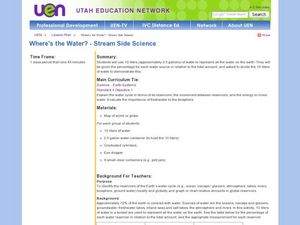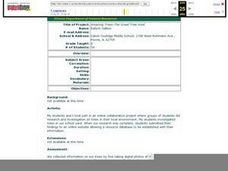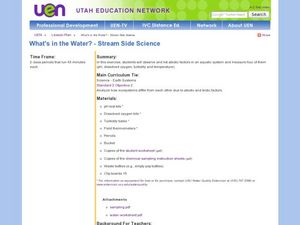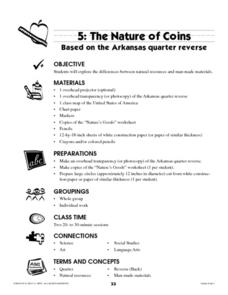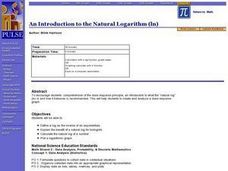Learning Games Lab
Nitrogen in Pollutants
Responsible farming is important for maintaining natural resources. Eager scientists complete a WebQuest to explore what happens to nitrogen when it enters the soil. They learn about the chemical makeup of nitrogen-based molecules and...
Purdue University
Coloration Exploration
Finding an animal in nature can be like a game of hide and seek. A thorough instructional activity explores different coloration strategies of animals. Pupils complete look-and-find puzzles and coloring sheets to differentiate between...
Curated OER
That's Predictable - Stream Side Science
Research the impact that changes in biotic or abiotic factors might have on an ecosystem. Debate for or against the changes and take action in the community. This resource ideally follows stream studies that young ecologists may have...
Curated OER
Where's the Water? Stream Side Science
After a whole-class discussion of water reservoirs, ten liters of water are given to each lab group to represent Earth's total amount of water. They divide the water into smaller containers, each representing one of those reservoirs. The...
Curated OER
Science: The Great Tree Hunt
Sixth graders participate in an online, cooperative project researching trees in their local environments for use in an online knowledge game. They take digital pictures of the trees, bark, and leaves. After completing their research,...
Curated OER
What's in the Water? - Stream Side Science
Here is a complete activity in which young biologists or ecologists test the pH, dissolved oxygen, turbidity and temperature of stream water. The class visits an actual stream and makes observations of the site. They use scientific...
Australian Government
The Great Artesian Basin
Covering 23% of the continent and holding 64,900 cubic kilometers of water, the Great Artesian Basin is the primary source of water for much of inland Australia. Using detailed student worksheets, experiments, and case studies, young...
Houghton Mifflin Harcourt
Zombie Ants
One of the creepiest and coolest natural occurrences is a great forum for data analysis and discussion! Explore the phenomenon of zombie ants, or ants infected with the Cordyceps fungus, with a series of activities and experiments. Kids...
Project WET Foundation
Use Water Wisely
What's the point in saving water? Surprisingly water isn't a forever resource because it is a natural resource. Here, young water conservationists hunt for 23 wise water users and water wasters by clicking on the people in the...
Biology Junction
Cell Reproduction
Cycles exist throughout nature, and the cell cycle compares to a life cycle of any other living being. A worksheet and presentation discuss the concepts of cell reproduction through the cell cycle. They cover each phase individually and...
Curated OER
Naturally Speaking
Students identify the Earth's natural resources and classify them as renewable or non-renewable. They simulate the distribution of resources and discuss the fairness and effectiveness of the distribution. They identify ways that they use...
Curated OER
Natural resource Race
Second graders answer true or false questions about natural resources. They stand on lines opposite each other and hop toward the middle if they answered the question correctly.
Curated OER
The Natural Selection of Stick-Worms
Students discuss and role-play the elements of natural selection. They use toothpicks to represent Stick-Worms and discover the mechanisms of change of traits in populations.
Curated OER
Natural Resource Awareness
Seventh graders design a collage that shows natural resources or things made from natural resources. They discuss the collages and decide how they use natural resources at home and school. They listen to a read aloud of a Native American...
Curated OER
The Nature of Coins
Pupils examine the Arkansas state quarter and identify natural resources depicted on the quarter. They compare natural resources to man-made resources and identify examples of each.
Curated OER
Our Natural Resources
Students investigate natural resources and man-made items. In this earth science lesson, students classify items from trash into man-made items or natural resources. Students construct a flow chart to investigate the life cycle of a...
Curated OER
Natural Disasters
Students investigate why natural catastrophes occur around the world and the results of such catastrophes. They investigate how people recover from catastrophes and can they be prevented. Students create their own work of art depicting a...
Curated OER
Introduction to Natural Selection
Students develop an understanding of natural selection, specifically, how it unfolds from generation to generation.
Curated OER
Quiz on Natural Resources #1
In this physical science worksheet, students complete an 8 question multiple choice online interactive quiz about the natural resources and fossil fuels. The quiz may also be printed and completed on paper.
Curated OER
Natural Selection
Eighth graders define natural selection and adaptation. They simulate natural selection within a species and relate the elements of natural selection to the simulation. They analyze the results of natural selection in terms of...
Curated OER
Natural Selection
Students construct a working definition of the word "evolution," and list the key points of Darwin's theory of natural selection. They create paper moths to help them explain the importance of camouflage and how it relates to natural...
Curated OER
Introduction To Natural Selection
Seventh graders investigate the concept of natural selection and it relation to the theory of evolution. They create a definition for classification based upon looking at other subjects that are similar. The variation of species is...
Curated OER
An Introduction to the Natural Logarithm (ln)
Students explore the dose response principle, an introduction to what the "natural log" (ln) is and how it behaves. They create and analyze a dose response graph.
Curated OER
Natural Selection
Pupils comprehend that natural selectionis the tool for adaptation and evolution of populations. They pick three M&M's and no candy corns. Students tally the number of different color M&M's chosen. They discuss why colors were...
Other popular searches
- History and Nature of Science
- The Nature of Science
- Nature of Science Biology
- Nature of Science Inquiry
- Nature of Science Physics
- History Nature of Science
- Science Patterns in Nature
- Genetics Nature of Science
- Teaching Nature of Science
- Nature of Science Weather
- Genetic Nature of Science
- Science and Nature





